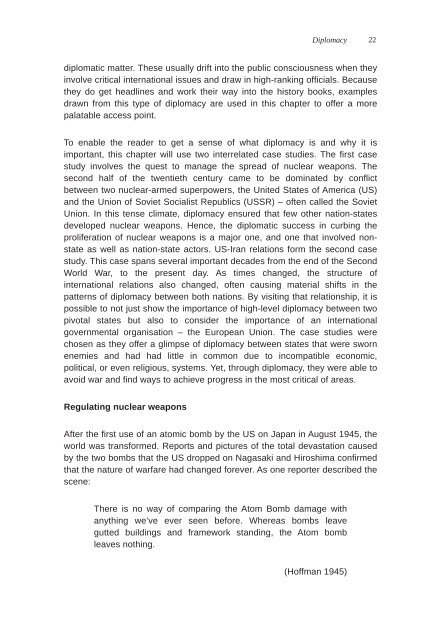International Relations
International-Relations-E-IR
International-Relations-E-IR
You also want an ePaper? Increase the reach of your titles
YUMPU automatically turns print PDFs into web optimized ePapers that Google loves.
Diplomacy<br />
22<br />
diplomatic matter. These usually drift into the public consciousness when they<br />
involve critical international issues and draw in high-ranking officials. Because<br />
they do get headlines and work their way into the history books, examples<br />
drawn from this type of diplomacy are used in this chapter to offer a more<br />
palatable access point.<br />
To enable the reader to get a sense of what diplomacy is and why it is<br />
important, this chapter will use two interrelated case studies. The first case<br />
study involves the quest to manage the spread of nuclear weapons. The<br />
second half of the twentieth century came to be dominated by conflict<br />
between two nuclear-armed superpowers, the United States of America (US)<br />
and the Union of Soviet Socialist Republics (USSR) – often called the Soviet<br />
Union. In this tense climate, diplomacy ensured that few other nation-states<br />
developed nuclear weapons. Hence, the diplomatic success in curbing the<br />
proliferation of nuclear weapons is a major one, and one that involved nonstate<br />
as well as nation-state actors. US-Iran relations form the second case<br />
study. This case spans several important decades from the end of the Second<br />
World War, to the present day. As times changed, the structure of<br />
international relations also changed, often causing material shifts in the<br />
patterns of diplomacy between both nations. By visiting that relationship, it is<br />
possible to not just show the importance of high-level diplomacy between two<br />
pivotal states but also to consider the importance of an international<br />
governmental organisation – the European Union. The case studies were<br />
chosen as they offer a glimpse of diplomacy between states that were sworn<br />
enemies and had had little in common due to incompatible economic,<br />
political, or even religious, systems. Yet, through diplomacy, they were able to<br />
avoid war and find ways to achieve progress in the most critical of areas.<br />
Regulating nuclear weapons<br />
After the first use of an atomic bomb by the US on Japan in August 1945, the<br />
world was transformed. Reports and pictures of the total devastation caused<br />
by the two bombs that the US dropped on Nagasaki and Hiroshima confirmed<br />
that the nature of warfare had changed forever. As one reporter described the<br />
scene:<br />
There is no way of comparing the Atom Bomb damage with<br />
anything we’ve ever seen before. Whereas bombs leave<br />
gutted buildings and framework standing, the Atom bomb<br />
leaves nothing.<br />
(Hoffman 1945)


